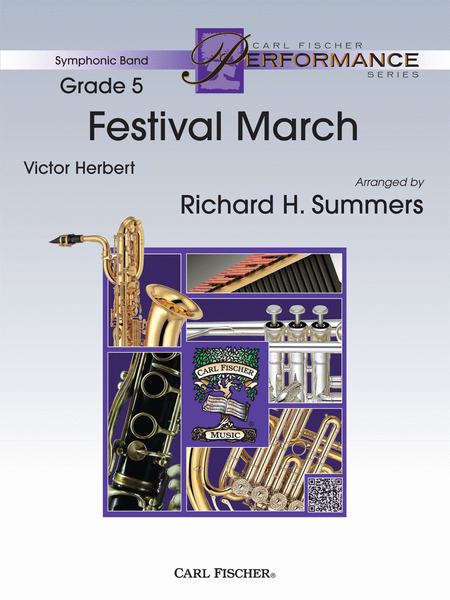Festival March
-
Ships in 24 hours
Details
Description
SKU: CF.SPS78
Composed by Victor Herbert. Symphonic Band (SPS). Set of Score and Parts. With Standard notation. 3+12+12+6+6+3+12+24+24+6+6+8+8+6+6+9+18+18+27+8+8+8+8+9+9+9+9+12+3+6+6+40+6 pages. Duration 7:37. Carl Fischer Music #SPS78. Published by Carl Fischer Music (CF.SPS78).ISBN 9781491152553. UPC: 680160910052. Key: Bb major.
Festival March is presented in a new edition arranged by Richard Summers. It is a tour de force composition for advanced bands and hearkens back to a bygone era during the golden age of the band movement. Directors and students will hear operatic music from composer Victor Herbert who is best known for his Christmas classic, Toyland. This is a richly scored masterpiece that deserves to return to "standard" status in concert band repertoire. We are proud to bring you this new setting of this cherished classic.
Festival March by Victor Herbert was written for the Pittsburgh Symphony and first performed under Herbert’s direction in Chicago on Dec. 9, 1901 celebrating the 12th anniversary of Chicago’s Auditorium Theatre. Also known as the Auditorium Festival March, he included it many times for programs of a festival nature. The main theme Auld Lang Syne, a famous Scottish folk song, is incorporated many times along with brass fanfares, interludes and march melodies. This band arrangement is very similar to the original orchestral composition. The missing string parts, the addition of the saxophone section and other band instruments, editing of the superimposed triplets against sixteenth notes, to one or the other, and articulations suitable for the band, were major challenges. The style of early twentieth-century American music is captured here. This arrangement will give band musicians access to a fine piece of music that could only be appreciated by orchestra musicians up to now. Although suitable for many occasions, this piece is a great way to begin or end a December holiday concert. Notes to the ConductorVictor Herbert’s music can be interpreted in a romantic style, which is the conductor’s responsibility to read in nuance and musicality. The beginning and other triple-tonguing sections of this piece have a "March of the Toys" quality to it. The interludes and Auld Lang Syne sections are legato and musical. The March sections can also be shaped musically.About the ComposerVictor Herbert was born in Ireland in 1861 and raised in Germany. When he moved to America in 1886, he joined the Metropolitan Opera as principal cellist and eventually composed many works including forty-three operettas on Broadway from the 1890s to World War I, including Naughty Marietta and Babes in Toyland. Victor Herbert conducted the Pittsburgh Symphony from 1898 to 1904 and then was the conductor of his own Victor Herbert Orchestra. He formed ASCAP with a group of composers in 1914 and was the director until his death in 1924. Among his thirty-one compositions for orchestra, Festival March was a favorite of his and was eventually published by Carl Fischer Music. .

 Share
Share